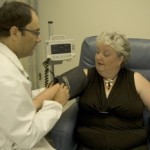Hindsight: Effect of Cardiac Rehab on Body Weights
Saturday, September 1, 2012 in 2004, we published a paper in the Journal of Cardiopulmonary Rehabilitation, in which we looked at the relationship between metabolic profiles and exercise capacity in overweight and obese patients participating in an outpatient cardiac rehabilitation program.
in 2004, we published a paper in the Journal of Cardiopulmonary Rehabilitation, in which we looked at the relationship between metabolic profiles and exercise capacity in overweight and obese patients participating in an outpatient cardiac rehabilitation program.
our retrospective analysis of cross-sectional data for 3542 patients, ages 63 +/- 11 years, showed that 81% of the patients had a BMI exceeding 25, and that 35% of the patients were obese (BMI > 30).
After adjustment for age, sex, smoking, hypertension, diabetes, and peak power output, BMI remained a significant independent predictor of a higher total cholesterol level, higher fasting blood glucose and triglyceride levels, and lower levels of high-density lipoprotein cholesterol.
Based on the Adult Treatment Panel III criteria, 77% of the obese males in classes 2 and 3 had three or more risk factors for the metabolic syndrome, as compared with 68% of the obese females in this obesity BMI class.
After 24 weeks of intervention, the outcome data (available for 1353 patients) showed that despite no change in body weight, all the BMI groups demonstrated significant improvements in metabolic profiles and peak exercise capacity.
This study clearly shows that cardiac rehabilitation results in significant improvement in the cardiovascular risk profile at all levels of BMI, independently of weight loss.
What and how much weight loss would add to these outcomes clearly has yet to be demonstrated.
Given that, by definition, all of the obese patients in this study would be considered to have at least Edmonton Obesity Stage 3 obesity, we clearly find that benefits from increasing exercise capacity and improving diet can improve metabolic parameters even if little weight is lost.
This does not mean that losing weight may not have additional benefits – it just shows that just because your patient is not losing weight, doesn’t mean they’re not getting healthier.
AMS
Cambridge, UK


